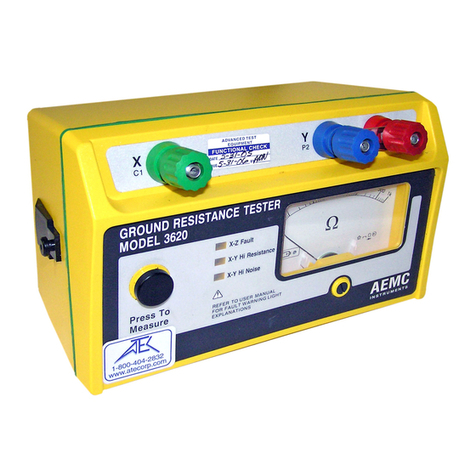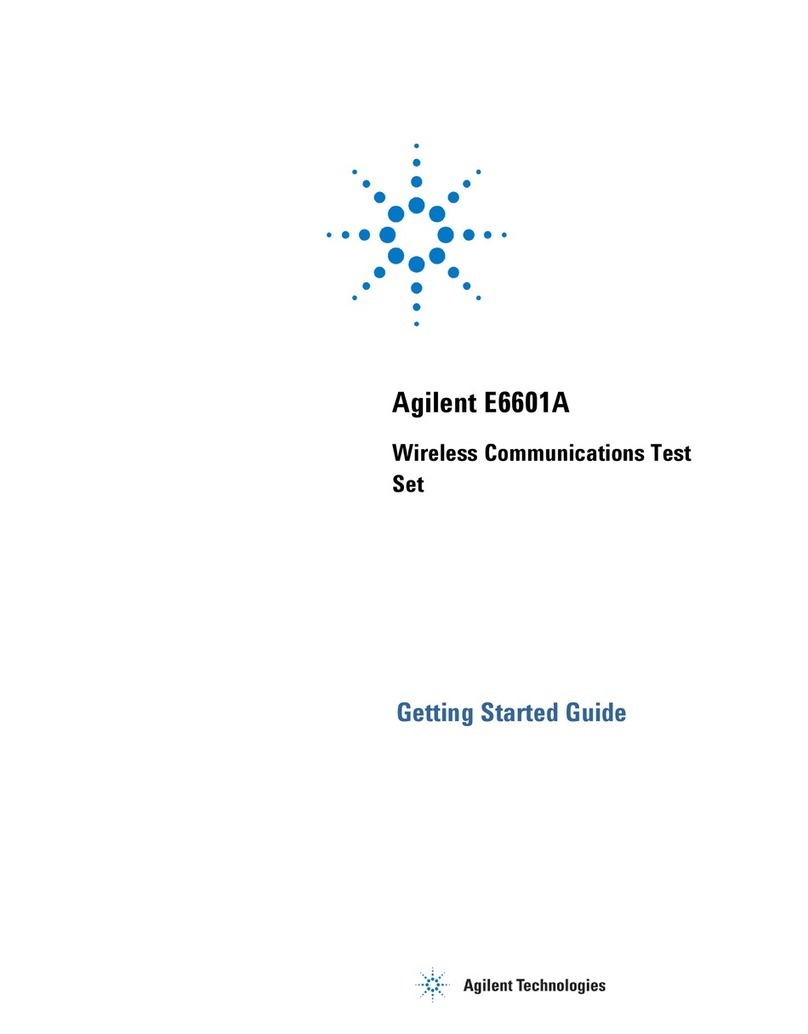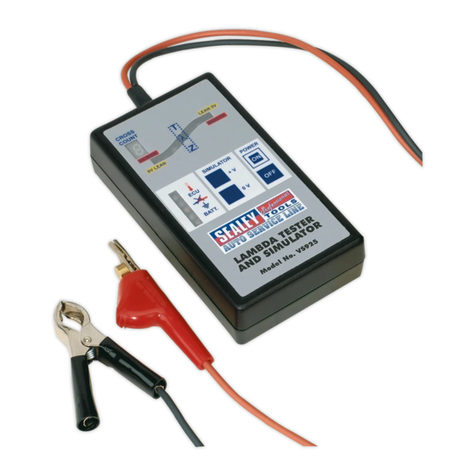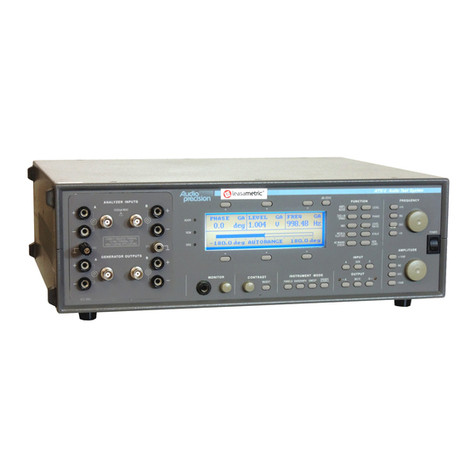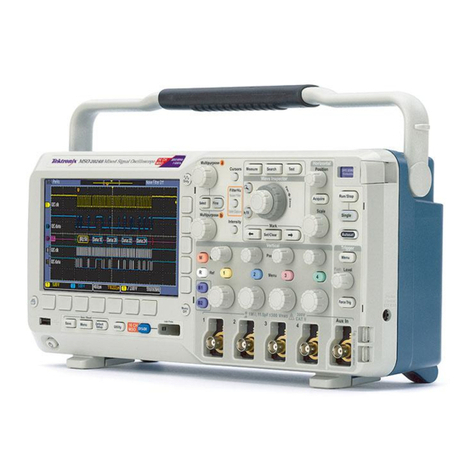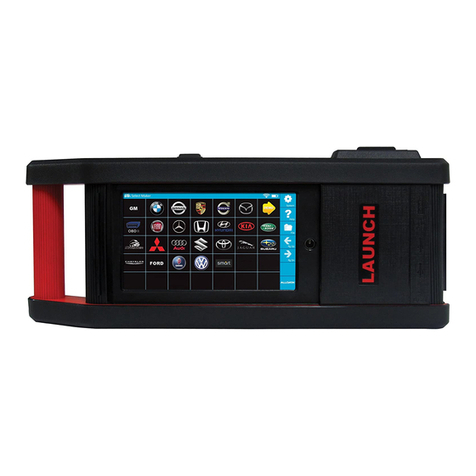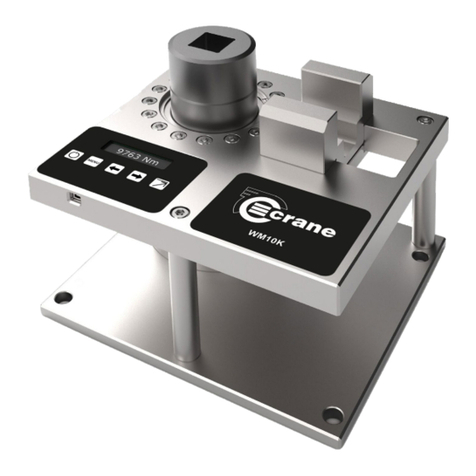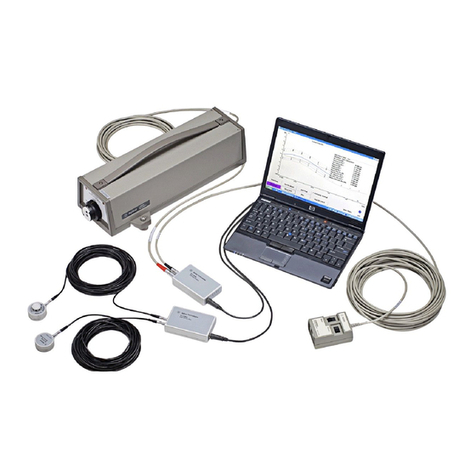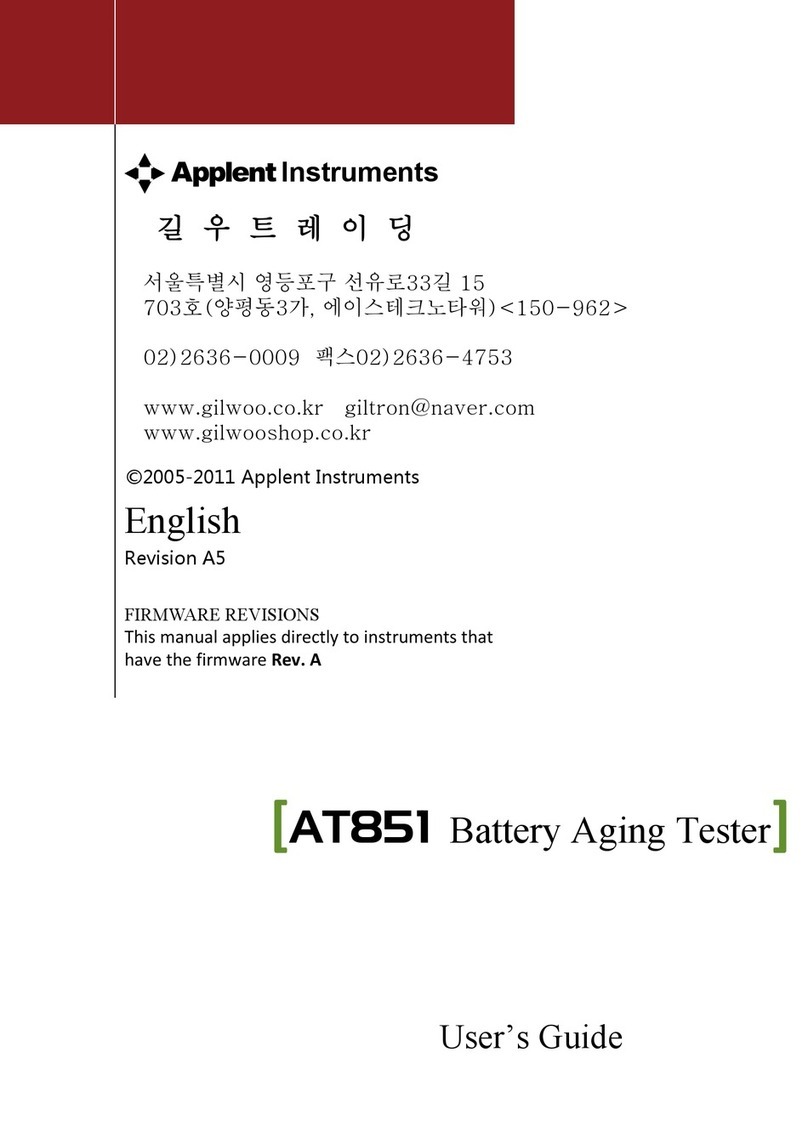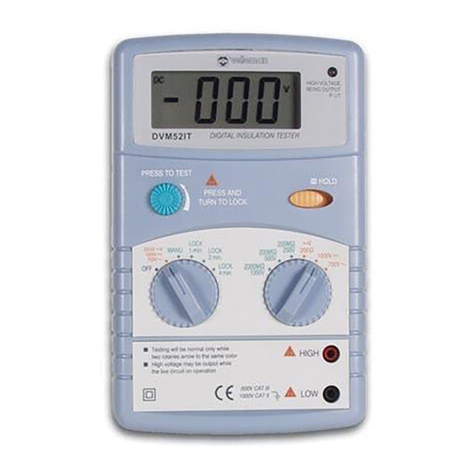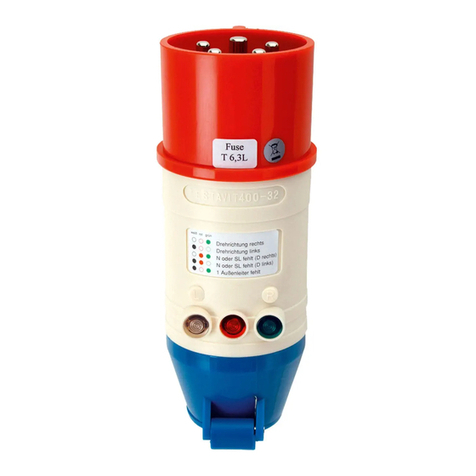GenRad GR228X Reference manual

Symbol onequipmentsignifiesthatthemanualcontains
informationtoprevent injuryor equipmentdamage. Referto
page vi and to other manuals in set.
IEC417
!
GR228X Test Systems
NT Version
Introduction to
9007-4008-03 Printed in U.S.A.

ii
CopyrightGenRad,Inc.1999.AllrightsreservedundercopyrightlawsoftheUnitedStatesandothercountries.Thetechnicaldata
includedherein,excludingcomputersoftwaredocumentation,issubjecttotheLIMITEDRIGHTSassetforthinFAR52.227-15(JUN
1987) and DFARS 252.227-7015 (JUN 1995). All technical data and computer software documentation contained herein is
proprietary and confidential to GenRad, Inc. or its licensor. All computer software documentation contained herein isCommercial
Computer Software Documentation, proprietary to GenRad, Inc. or its licensor and furnished under limited license only. For
solicitationsissued bythe UnitedStates, itsagenciesorinstrumentalities (the“Government”) onor afterDecember 1,1995 andthe
Department of Defense (“DoD”) on or after September 29, 1995, the only rights provided in the Commercial Computer Software
Documentation shall be those specified in a license customarily provided to the public by GenRad, Inc. in accordance with FAR
12.212 (a) and (b) (OCT 1995) or DFARS 227.7202-3 (a) (JUN 1995). For solicitations issued before December 1, 1995 by the
Government(otherthanDoD)use,duplicationordisclosureofthedocumentationshallbesubjectto theRESTRICTEDRIGHTSas
set forth in subparagraph (c) (1) and (2) of the commercial computer software – restricted rights clause at FAR 52.227-19 (JUN
1987). For solicitations issued before September 29, 1995 by DoD: RESTRICTED RIGHTS LEGEND – The use, duplication, or
disclosure by the Government is subject to restrictions as set forth in subparagraph (c) (1) (ii) of the Rights in Technical Data and
Computer Software clause at DFARS 252.227-7013 (OCT 1988).
The following are trademarks or registered trademarks of GenRad, Inc.:
7Xpress
Access Remote Support
AccuWave
A New Way of Thinking
ATG–32
ATG XPRESS
AutoDebug Plus
BasicSCAN
BugHound
BusBust
Cap Xpress
ChipCheck
Diamon
Digibridge
Dr. Test
ENCOMPASS
ETG
FAST
FASTCELL
GENESIS
GENEVA
GenRad
GPTI
GR
GR AccelerATE
GR logos
GR Navigate
GRnet
GR Pilot
GR TestStation
GRXpert
GR Versa
ISOcal
JDS
Junction Xpress
Opens Xpress
OptomATE
Orient Xpress
Panel-Test
Paragon
PATH
PinPoint
Program Xplorer
PXIscan
Scan Pathfinder
Scratchprobe
Scratchprobing
SFDM
SFLM
Shop Floor Data Manager
Shop Floor Line Manager
SoftProbe
SpeedPlus
Stinger
TestFlo
TEST XPRESS
The Difference in
Software is the
Difference in Test
The Technology of
Knowledge
TRACS
TRACS III
VIPER
VXIscan
XL
XP
Xpress Model
Xpress Nail
XtendedPerformance
Product names listed are trademarks of their respective manufacturers. Company names listed are trademarks or trade names of
their respective companies.
The material in this manual is for informational purposes only and is subject to change, without notice. GenRad assumes no
responsibilityforanyerrororforconsequentialdamagesthatmayresultfromtheuseormisinterpretationofanyoftheprocedures
in this publication.

iii
GenRad
WeatGenRadstrivetoachievethehighestpossiblecustomersatisfactionthroughinnovativeproductsandservices,
and continuous improvement of our product quality and support.
To help us achieve our goal, we ask that you:
zPlease fill out and return the Reader Comments card, located at the back of this manual, if you have any
suggestions for structure or content improvements.
zPlease document any product problems or enhancement requests on the GenRad System Performance
Report forms, supplied with the equipment documentation, and return them to the GenRad Customer
Care Center (CCC). The contact addresses are in the Preface of this manual.
Thank you for choosing GenRad as your integrated diagnostic solutions provider.

v
December, 1999
Total number of pages in this publication is 114.
List of Effecti e Pages
Manual and Binder Reorder No.DateIssue
Original
Page No. Issue
Title Original. . . . . . . . . . . . . . . . . . . . .
ii through xvii Original. . . . . . . . . . . .
1–1 through 1–15 Original. . . . . . . . .
2–1 through 2–20 Original. . . . . . . . .
3–1 through 3–36 Original. . . . . . . . .
4–1 through 4–10 Original. . . . . . . . .
A–1 through A–3 Original. . . . . . . . . .
Index–1 through Index–5 Original. . .
N/A Manual Reorder No.
9007–4008–03

vi
WARNINGS
zDo not remove covers. Potentially lethal voltages are present inside the system. Observe all WARNING markings on the equip-
ment and WARNING notices in the manual. If servicing is necessary, it should be performed only by a qualified person familiar
with the electrical shock hazards present inside the system.
zGroundingcircuitcontinuityisvitalforsafeoperationoftheequipment. Neveroperateequipmentwithgroundingconduc-
tor disconnected.
zSafeguard your hands and fingers while handling any fixture or other accessory. Be sure it is securely supported if you
reach under it. If it is heavy, you must have another person help to move it.
zThesymbol !IEC417onequipmentsignifiesthatthemanualcontainsinformationtopreventinjuryorequipmentdamage.
ObserveandheedallWARNINGnoticesinthemanualsandtheequipment. WARNINGScallattentiontopersonnelsafe-
ty information.
zReplace any fuse only with the same type and ratings as labeled on the equipment and/or listed in the manual.
MISES EN GARDE
zNe pas enlever les couvercles. Les niveaux de tension se trouvant dans le système sont extrêmement dangereux.
Respectez toutes les consignes de sécuritéfigurant sur l’équipement et les MISES EN GARDE données dan ce
manuel. Seule une personne qualifée, connaisant les risques de décharge électrique du système, est autorisée à
effecteur les opérations de nettoyage ou de réparation du système.
zLe circuit doit être mis àla terre sans discontinuation pour garantir un fonctionnement sans danger de l’équipement. Ne
jamais faire fonctionner l’équipement pendant que le raccord àla terre est déconnecté.
zProtégez–vous les mains et les doigts pendant le maniement de tout dispositif de serrage ou autre accessoire.
Assurez–vous que ceux–ci soient bien solidement fixés en place, avant de vous pencher sous eux. Si l’accessoire en
question est trop lourd, faites–vous aider pour le déplacer.
zLesymbole !IEC417figurant surl’équipement signifie quelemanuel contientdesinformations permettant d’empêcher
les accidents ou l’endommagement de l’équipement. Respectez toutes les consignes de MISES EN GARDE données
dans le manuel et figurant sur l’équipement. Les MISES EN GARDE attirent l’attention sur la nécessitéde
se protéger.
zNe remplacez les fusibles qu’avec des fusibles du même type et de la même valuer que ceux mentionnés sur l’équipe-
ment et figurant dans le manuel.
WARNHINWEISE
zAbdeckungen nicht entfernen. Potentiell lebensgefährliche Spannungsbedingungen innerhalb des Systems vorhanden. Alle
auf der Einrichtung befindlichen WARNMARKIERUNGEN und im Handbuch enthaltenen WARNHINWEISE beachten.
Wartungsarbeiten dem qualifizierten Personal überlassen, das mit den innerhalb des Systems vorhandenen Gefahren eines
elektrischen Schlags vertraut ist.
zDie Erdung des Schaltungsdurchgangs ist eine Grundvoraussetzung für den sicheren Betrieb der Einrichtung.
Einrichtung niemals ohne Erdleiter betreiben.
zHände und Finger bei der Handhabung einer Spannvorrichtung oder eines anderen Zubehörteils schützen. Sich vor der
Plazierung der Hände unterhalb der Einrichtung vergewissern, daßdie Einrichtung über ausreichenden Halt verfügt. Falls die
Einrichtung schwer ist, sich von einer anderen Person beim Tragen helfen lassen.
zDas auf der Einrichtung befindliche Symbol !IEC417 bedeutet, daßdas Handbuch Informationen zur Verhinderung von
Körperverletzungen oder Sachschäden enthält. Alle in den Handbüchern enthaltenen und auf der Einrichtung befindlichen
WARNHINWEISE beachten und befolgen. WARNHINWEISE sollen auf Informationen zur persönlichen Sicherheit aufmerksam
machen.
zSicherungen nur durch Sicherungen des gleichen Typs und der gleichen Nennleistung ersetzen. Auf der Einrichtung befindliche
Etiketten und im Handbuch enthaltene Informationen zu Rate ziehen.

vii
AVISOS
zNão remova as tampas. Hávoltagens potencialmente fatais presentes na parte interna do sistema. Observe todas as
marcações de AVISOS no equipamento e discrições de AVISOS no manual. Se for necessário fazer manutenção, esta
deveserfeitasomenteporumapessoaqualificadafamiliarizadacomosperigosdechoqueselétricospresentesnaparte
interna do sistema.
zAcontinuidade docircuito deaterramentoévital paraaoperação seguradoequipamento. Nunca opere oequipamento
com o cabo de aterramento desligado.
zProtejaassuas mãosededosaooperarqualquerdispositivoououtroacessório. Certifique–sequeeleestejasuportado
comsegurançasevocêtiver quealcançaralgo debaixo dele. Sefor pesado, vocêdeveter a ajudadeuma outrapessoa
para movê–lo.
zO simbolo !IEC417no equipamento significa que o manual contém informações para prevenir ferimentos ou danos ao
equipamento. Observe e preste atenção a todos os AVISOS nos manuais e no equipamento. Os AVISOS chamam a
atenção a informações sobre a segurança pessoal.
zSubstituaqualquerfusivelsomentecomumdomesmotipoedamesmacapacidadenominalcomomarcadonoequipamen-
to e listado no manual.
ADVERTENCIAS
zNo quitar las tapas. En el interno del sistema hay voltajes potencialmente mortales. Obsérvense todos los rótulos de
ADVERTENCIApresentesenelequipo,asícomoladescripcióndelasnotasdeADVERTENCIApresentadasenelman-
ual. De ser necesario, el servicio demantenimiento deberáser efectuado únicamente por personal calificado que esté
familiarizado con los peligros de choque eléctrico presentes en el sistema.
zLa continuidad del circuito de puesta a tierra es de vital importancia para el functionamiento seguro del equipo. Nunca
se debe usar el equipo con el conductor de puesta a tierra desconectado.
zProtéjanselasmanos ylos dedostodavez quesea necesariomanipularun dispositivou accesorio. Cerciorarsede que
el mismo estéfirmemente sujetado antes de proceder a trabajar debajo de él. Si el aparato u accesorio fuera pesado,
pedir la ayuda de otra persona para moverlo.
zEl simbolo !IEC417que aparece en el equipo significa que el manual contiene informaciones para evitar lesiones per-
sonalesodañosal equipo. Obsérvense yprésteseatenciónatodalasnotasdeADVERTENCIApresentesenlosmanu-
ales y en el equipo. Las ADVERTENCIAS sirven para llamar la atención sobre informaciones de seguridad para el per-
sonal.
zReemplazar los fusibles únicamente con otros del mismo tipo y capacidad, según lo indique el rótulo en el equipo y la
descripción en el manual.

viii
CAUTIONS
zObserve and heed all CAUTION notices in the manuals and on the equipment. CAUTIONS call attention to information
about safeguarding equipment from damage.
HANDLING PRECAUTIONS FOR ELECTRONIC DEVICES SUBJECT TO DAMAGE BY STATIC ELECTRICITY
Place instrument or module to be serviced, spare parts in
conductive (anti–static) envelopes or carriers, hand tools
etc.onaworksurfacedefinedasfollows. Theworksurface
mustbeconductive and reliablyconnected toearth ground
through a safety resistance of approximately 250 kilohms.
The surface must NOT be metal. (A resistivity of 30 to 300
kilohms per square is suggested.) Avoid placing tools or
electrical parts on insulators.
Ground the frame of any line–powered equipment, test in-
struments, lamps, soldering irons, etc., directly to earth
ground. Toavoidshortingoutthesafetyresistance,besure
thatgroundedequipmenthasrubberfeetorothermeansof
insulation from the work surface. The module being serv-
iced should be insulated while grounded through the pow-
er–cord ground wire, but must be connected to the work
surface before, during and after any disassembly or other
procedure in which the line cord is disconnected.
Excludeany handtools (suchas non–conductiveplunger–
type solder suckers) that can generate a static charge.
Ground yourself reliably, through a resistance, to the work
surface; use, for example, a conductive strap or cable with
a wrist cuff. The cuff must make electrical contact directly
with your skin; do NOT wear it over clothing. (Resistance
betweenskincontact andwork surfacethroughacommer-
ciallyavailable personnelgrounding deviceis typically250
kilohms to 1 megohm.)
IfanycircuitorICpackagesaretobestoredortransported,
enclosetheminconductiveenvelopes or carriers. Remove
themonlywith theabove precautions;handle ICpackages
without touching the contact pins.
Avoid circumstances that are likely toproduce static charges,
such as wearing clothes of synthetic material, sitting on a
plastic–coveredstool(particularly whilewearingwool), comb-
ing your hair, or making extensive erasures. These circum-
stances are most significant when the air is dry.
When testing static sensitive devices, be sure dc power is
on before, during, and after application of test signals. Be
sure all pertinent voltages have been switched off while
boards or components are removed or inserted.

ix
Introduction to GR228X Test Systems
Contents
Preface
Overview xiii. . . . . . . . . . . . . . . . . . . . . . . . . . . . . . . . . . . . . . . . . . . . . . . . . . . . . . . . . . . . . . . . . . . . . . . . . . . . . . . .
Audience xiii. . . . . . . . . . . . . . . . . . . . . . . . . . . . . . . . . . . . . . . . . . . . . . . . . . . . . . . . . . . . . . . . . . . . . . . . . . . . . . . .
About this Manual xiv. . . . . . . . . . . . . . . . . . . . . . . . . . . . . . . . . . . . . . . . . . . . . . . . . . . . . . . . . . . . . . . . . . . . . . . .
Related GenRad Documentation xv. . . . . . . . . . . . . . . . . . . . . . . . . . . . . . . . . . . . . . . . . . . . . . . . . . . . . . . . . . .
Document Conventions xvi. . . . . . . . . . . . . . . . . . . . . . . . . . . . . . . . . . . . . . . . . . . . . . . . . . . . . . . . . . . . . . . . . . .
GenRad Customer Care Center xvii. . . . . . . . . . . . . . . . . . . . . . . . . . . . . . . . . . . . . . . . . . . . . . . . . . . . . . . . . . . .
Overview
GR228X System Architecture 1-2. . . . . . . . . . . . . . . . . . . . . . . . . . . . . . . . . . . . . . . . . . . . . . . . . . . . . . . . . . . . . .
Basic System Components 1-3. . . . . . . . . . . . . . . . . . . . . . . . . . . . . . . . . . . . . . . . . . . . . . . . . . . . . . . . . . . .
System Activities 1-4. . . . . . . . . . . . . . . . . . . . . . . . . . . . . . . . . . . . . . . . . . . . . . . . . . . . . . . . . . . . . . . . . . . . . . . . .
Testing Methods 1-4. . . . . . . . . . . . . . . . . . . . . . . . . . . . . . . . . . . . . . . . . . . . . . . . . . . . . . . . . . . . . . . . . . . . . . . . . .
In-Circuit Testing 1-6. . . . . . . . . . . . . . . . . . . . . . . . . . . . . . . . . . . . . . . . . . . . . . . . . . . . . . . . . . . . . . . . . . . . .
Functional Testing 1-7. . . . . . . . . . . . . . . . . . . . . . . . . . . . . . . . . . . . . . . . . . . . . . . . . . . . . . . . . . . . . . . . . . . .
System Test Devices 1-8. . . . . . . . . . . . . . . . . . . . . . . . . . . . . . . . . . . . . . . . . . . . . . . . . . . . . . . . . . . . . . . . . . . . . .
Testing Board Continuity 1-11. . . . . . . . . . . . . . . . . . . . . . . . . . . . . . . . . . . . . . . . . . . . . . . . . . . . . . . . . . . . . . .
Testing Analog Components 1-11. . . . . . . . . . . . . . . . . . . . . . . . . . . . . . . . . . . . . . . . . . . . . . . . . . . . . . . . . . .
Testing Digital Components 1-12. . . . . . . . . . . . . . . . . . . . . . . . . . . . . . . . . . . . . . . . . . . . . . . . . . . . . . . . . . . .
Testing Hybrid Components 1-13. . . . . . . . . . . . . . . . . . . . . . . . . . . . . . . . . . . . . . . . . . . . . . . . . . . . . . . . . . . .
Testing Boundary Scan Components 1-14. . . . . . . . . . . . . . . . . . . . . . . . . . . . . . . . . . . . . . . . . . . . . . . . . . . .
Test Fixtures 1-15. . . . . . . . . . . . . . . . . . . . . . . . . . . . . . . . . . . . . . . . . . . . . . . . . . . . . . . . . . . . . . . . . . . . . . . . . . . . .
In-Circuit Test Fixture 1-15. . . . . . . . . . . . . . . . . . . . . . . . . . . . . . . . . . . . . . . . . . . . . . . . . . . . . . . . . . . . . . . . .
Functional Test Fixture 1-15. . . . . . . . . . . . . . . . . . . . . . . . . . . . . . . . . . . . . . . . . . . . . . . . . . . . . . . . . . . . . . . .

xContents
GR228X Test Systems
GR228X System Configurations 2-1. . . . . . . . . . . . . . . . . . . . . . . . . . . . . . . . . . . . . . . . . . . . . . . . . . . . . . . . . . . .
GR2280 and GR2281 Production Test Systems 2-3. . . . . . . . . . . . . . . . . . . . . . . . . . . . . . . . . . . . . . . . . . . . . .
Standard System Hardware 2-4. . . . . . . . . . . . . . . . . . . . . . . . . . . . . . . . . . . . . . . . . . . . . . . . . . . . . . . . . . . .
Optional Hardware 2-4. . . . . . . . . . . . . . . . . . . . . . . . . . . . . . . . . . . . . . . . . . . . . . . . . . . . . . . . . . . . . . . . . . . .
GR2281A and GR2287A Production Test Systems 2-5. . . . . . . . . . . . . . . . . . . . . . . . . . . . . . . . . . . . . . . . . . . .
Standard System Hardware 2-6. . . . . . . . . . . . . . . . . . . . . . . . . . . . . . . . . . . . . . . . . . . . . . . . . . . . . . . . . . . .
Optional Hardware 2-6. . . . . . . . . . . . . . . . . . . . . . . . . . . . . . . . . . . . . . . . . . . . . . . . . . . . . . . . . . . . . . . . . . . .
GR228X i-Series Test Systems 2-7. . . . . . . . . . . . . . . . . . . . . . . . . . . . . . . . . . . . . . . . . . . . . . . . . . . . . . . . . . . . .
Standard Hardware 2-8. . . . . . . . . . . . . . . . . . . . . . . . . . . . . . . . . . . . . . . . . . . . . . . . . . . . . . . . . . . . . . . . . . .
Optional Hardware 2-9. . . . . . . . . . . . . . . . . . . . . . . . . . . . . . . . . . . . . . . . . . . . . . . . . . . . . . . . . . . . . . . . . . . .
GR228X e-Series Test Systems 2-10. . . . . . . . . . . . . . . . . . . . . . . . . . . . . . . . . . . . . . . . . . . . . . . . . . . . . . . . . . . .
Standard System Hardware 2-11. . . . . . . . . . . . . . . . . . . . . . . . . . . . . . . . . . . . . . . . . . . . . . . . . . . . . . . . . . . .
Optional Hardware 2-12. . . . . . . . . . . . . . . . . . . . . . . . . . . . . . . . . . . . . . . . . . . . . . . . . . . . . . . . . . . . . . . . . . . .
GR2283 and GR2284 Test Systems 2-13. . . . . . . . . . . . . . . . . . . . . . . . . . . . . . . . . . . . . . . . . . . . . . . . . . . . . . . .
Standard System Hardware 2-14. . . . . . . . . . . . . . . . . . . . . . . . . . . . . . . . . . . . . . . . . . . . . . . . . . . . . . . . . . . .
Optional Hardware 2-14. . . . . . . . . . . . . . . . . . . . . . . . . . . . . . . . . . . . . . . . . . . . . . . . . . . . . . . . . . . . . . . . . . . .
GR228X Test Systems with Windows NT PC Retrofit 2-15. . . . . . . . . . . . . . . . . . . . . . . . . . . . . . . . . . . . . . . . . .
Standard System Hardware 2-16. . . . . . . . . . . . . . . . . . . . . . . . . . . . . . . . . . . . . . . . . . . . . . . . . . . . . . . . . . . .
Optional Hardware 2-17. . . . . . . . . . . . . . . . . . . . . . . . . . . . . . . . . . . . . . . . . . . . . . . . . . . . . . . . . . . . . . . . . . . .
UUT Power Supplies 2-18. . . . . . . . . . . . . . . . . . . . . . . . . . . . . . . . . . . . . . . . . . . . . . . . . . . . . . . . . . . . . . . . . . . . . .
Available UUT Power Supplies 2-19. . . . . . . . . . . . . . . . . . . . . . . . . . . . . . . . . . . . . . . . . . . . . . . . . . . . . . . . .
Optional Programmable Voltage UUT Power Supplies 2-20. . . . . . . . . . . . . . . . . . . . . . . . . . . . . . . . . . . . .
Optional Fixed Voltage Power Supplies 2-20. . . . . . . . . . . . . . . . . . . . . . . . . . . . . . . . . . . . . . . . . . . . . . . . . .
GR228X Test Software
Test Development Process 3-2. . . . . . . . . . . . . . . . . . . . . . . . . . . . . . . . . . . . . . . . . . . . . . . . . . . . . . . . . . . . . . . .
Test Preparation Tools 3-3. . . . . . . . . . . . . . . . . . . . . . . . . . . . . . . . . . . . . . . . . . . . . . . . . . . . . . . . . . . . . . . . . . . .
CB/Test 3-3. . . . . . . . . . . . . . . . . . . . . . . . . . . . . . . . . . . . . . . . . . . . . . . . . . . . . . . . . . . . . . . . . . . . . . . . . . . . .
Circuit Description Generator 3-4. . . . . . . . . . . . . . . . . . . . . . . . . . . . . . . . . . . . . . . . . . . . . . . . . . . . . . . . . .
System Device Libraries 3-4. . . . . . . . . . . . . . . . . . . . . . . . . . . . . . . . . . . . . . . . . . . . . . . . . . . . . . . . . . . . . . .
Model Generation 3-9. . . . . . . . . . . . . . . . . . . . . . . . . . . . . . . . . . . . . . . . . . . . . . . . . . . . . . . . . . . . . . . . . . . .
Power Supply Editor 3-15. . . . . . . . . . . . . . . . . . . . . . . . . . . . . . . . . . . . . . . . . . . . . . . . . . . . . . . . . . . . . . . . . .
Test Generation Tools 3-16. . . . . . . . . . . . . . . . . . . . . . . . . . . . . . . . . . . . . . . . . . . . . . . . . . . . . . . . . . . . . . . . . . . . .
Automatic Test Generator 3-16. . . . . . . . . . . . . . . . . . . . . . . . . . . . . . . . . . . . . . . . . . . . . . . . . . . . . . . . . . . . . .
Preprocessor 3-17. . . . . . . . . . . . . . . . . . . . . . . . . . . . . . . . . . . . . . . . . . . . . . . . . . . . . . . . . . . . . . . . . . . . . . . .
Scan Pathfinder 3-17. . . . . . . . . . . . . . . . . . . . . . . . . . . . . . . . . . . . . . . . . . . . . . . . . . . . . . . . . . . . . . . . . . . . . .
Nail Assignment 3-19. . . . . . . . . . . . . . . . . . . . . . . . . . . . . . . . . . . . . . . . . . . . . . . . . . . . . . . . . . . . . . . . . . . . . .
Translator 3-19. . . . . . . . . . . . . . . . . . . . . . . . . . . . . . . . . . . . . . . . . . . . . . . . . . . . . . . . . . . . . . . . . . . . . . . . . . .
Test Debug Tools 3-20. . . . . . . . . . . . . . . . . . . . . . . . . . . . . . . . . . . . . . . . . . . . . . . . . . . . . . . . . . . . . . . . . . . . . . . . .
Program Xplorer 3-20. . . . . . . . . . . . . . . . . . . . . . . . . . . . . . . . . . . . . . . . . . . . . . . . . . . . . . . . . . . . . . . . . . . . . .
Autodebug 3-21. . . . . . . . . . . . . . . . . . . . . . . . . . . . . . . . . . . . . . . . . . . . . . . . . . . . . . . . . . . . . . . . . . . . . . . . . .
Digital Waveform Display 3-22. . . . . . . . . . . . . . . . . . . . . . . . . . . . . . . . . . . . . . . . . . . . . . . . . . . . . . . . . . . . . .
Measuring Fault Coverage (ALLFAULT) 3-24. . . . . . . . . . . . . . . . . . . . . . . . . . . . . . . . . . . . . . . . . . . . . . . . .
Floating Point Array Display 3-25. . . . . . . . . . . . . . . . . . . . . . . . . . . . . . . . . . . . . . . . . . . . . . . . . . . . . . . . . . . .

xi
Introduction to GR228X Test Systems
Generating a Plot 3-27. . . . . . . . . . . . . . . . . . . . . . . . . . . . . . . . . . . . . . . . . . . . . . . . . . . . . . . . . . . . . . . . . . . . . . . . .
Test Execution Tools 3-27. . . . . . . . . . . . . . . . . . . . . . . . . . . . . . . . . . . . . . . . . . . . . . . . . . . . . . . . . . . . . . . . . . . . . .
Standard Test Software 3-27. . . . . . . . . . . . . . . . . . . . . . . . . . . . . . . . . . . . . . . . . . . . . . . . . . . . . . . . . . . . . . .
PinPoint Guided Probe 3-29. . . . . . . . . . . . . . . . . . . . . . . . . . . . . . . . . . . . . . . . . . . . . . . . . . . . . . . . . . . . . . . .
TEST XPRESS 3-29. . . . . . . . . . . . . . . . . . . . . . . . . . . . . . . . . . . . . . . . . . . . . . . . . . . . . . . . . . . . . . . . . . . . . .
Panel Test, Split Fixturing, and Serial Numbering 3-31. . . . . . . . . . . . . . . . . . . . . . . . . . . . . . . . . . . . . . . . .
Test Analysis Tools 3-31. . . . . . . . . . . . . . . . . . . . . . . . . . . . . . . . . . . . . . . . . . . . . . . . . . . . . . . . . . . . . . . . . . . . . . .
Real Time Data Collection 3-31. . . . . . . . . . . . . . . . . . . . . . . . . . . . . . . . . . . . . . . . . . . . . . . . . . . . . . . . . . . . .
Data Display 3-34. . . . . . . . . . . . . . . . . . . . . . . . . . . . . . . . . . . . . . . . . . . . . . . . . . . . . . . . . . . . . . . . . . . . . . . . .
Off-line Programming 3-35. . . . . . . . . . . . . . . . . . . . . . . . . . . . . . . . . . . . . . . . . . . . . . . . . . . . . . . . . . . . . . . . . . . . .
ATG Xpress 3-35. . . . . . . . . . . . . . . . . . . . . . . . . . . . . . . . . . . . . . . . . . . . . . . . . . . . . . . . . . . . . . . . . . . . . . . . .
TRACS III 3-35. . . . . . . . . . . . . . . . . . . . . . . . . . . . . . . . . . . . . . . . . . . . . . . . . . . . . . . . . . . . . . . .. . . . . . . . . . .
GRXpert 3-35. . . . . . . . . . . . . . . . . . . . . . . . . . . . . . . . . . . . . . . . . . . . . . . . . . . . . . . . . . . . . . . . . . . . . . . . . . . .
Migrating from One Test System to Another 3-36. . . . . . . . . . . . . . . . . . . . . . . . . . . . . . . . . . . . . . . . . . . . . . . . . .
Windows NT System Environment
Editors 4-1. . . . . . . . . . . . . . . . . . . . . . . . . . . . . . . . . . . . . . . . . . . . . . . . . . . . . . . . . . . . . . . . . . . . . . . . . . . . . . . . . .
PFE Editor 4-2. . . . . . . . . . . . . . . . . . . . . . . . . . . . . . . . . . . . . . . . . . . . . . . . . . . . . . . . . . . . . . . . . . . . . . . . . .
emacs 4-3. . . . . . . . . . . . . . . . . . . . . . . . . . . . . . . . . . . . . . . . . . . . . . . . . . . . . . . . . . . . . . . . . . . . . . . . . . . . . .
vim 4-3. . . . . . . . . . . . . . . . . . . . . . . . . . . . . . . . . . . . . . . . . . . . . . . . . . . . . . . . . . . . . . . . . . . . . . . . . . . . . . . . .
Choosing a User Interface 4-4. . . . . . . . . . . . . . . . . . . . . . . . . . . . . . . . . . . . . . . . . . . . . . . . . . . . . . . . . . . . . . . . .
TestFlo Program Preparation Manager (PPM) 4-4. . . . . . . . . . . . . . . . . . . . . . . . . . . . . . . . . . . . . . . . . . . .
GR228X Monitor 4-5. . . . . . . . . . . . . . . . . . . . . . . . . . . . . . . . . . . . . . . . . . . . . . . . . . . . . . . . . . . . . . . . . . . . .
Online Help 4-6. . . . . . . . . . . . . . . . . . . . . . . . . . . . . . . . . . . . . . . . . . . . . . . . . . . . . . . . . . . . . . . . . . . . . . . . . . . . . .
Monitor Page Help 4-6. . . . . . . . . . . . . . . . . . . . . . . . . . . . . . . . . . . . . . . . . . . . . . . . . . . . . . . . . . . . . . . . . . . .
Online Help Topics 4-6. . . . . . . . . . . . . . . . . . . . . . . . . . . . . . . . . . . . . . . . . . . . . . . . . . . . . . . . . . . . . . . . . . . .
Online Manuals 4-10. . . . . . . . . . . . . . . . . . . . . . . . . . . . . . . . . . . . . . . . . . . . . . . . . . . . . . . . . . . . . . . . . . . . . .
Documentation Quick Reference
Hardware Documentation A-1. . . . . . . . . . . . . . . . . . . . . . . . . . . . . . . . . . . . . . . . . . . . . . . . . . . . . . . . . . . . . . . . . .
Software Documentation A-2. . . . . . . . . . . . . . . . . . . . . . . . . . . . . . . . . . . . . . . . . . . . . . . . . . . . . . . . . . . . . . . . . .
Third Party Documentation A-3. . . . . . . . . . . . . . . . . . . . . . . . . . . . . . . . . . . . . . . . . . . . . . . . . . . . . . . . . . . . . . . .
Index

xiii
Introduction to GR228X Test Systems
Preface
Overview
This manual introduces you to the GR228X Test Systems by providing you with a brief description
of the:
zGR228X Test System architecture.
zStandard and optional hardware available for each GR228X Test System.
zSoftware that is available to help you develop test programs, and which manual in the
GR228X Documentation Set provides detailed information.
zWindows NT-based system environment.
Audience
This manual will benefit:
zNetwork Manager or Administrator
zSystem Manager or Administrator
zTest Engineer
zField Service Personnel
zSite Manager
zTest Programmer
zOperator

xiv Preface
About this Manual
This section identifies the knowledge or tasks described in the chapters or appendices of this manual.
For information about Read this Chapter or Appendix
The general GR228X System’s architecture,
testing strategies, devices tested, and test
fixtures
Overview
The standard and optional hardware that is
available on your GR228X System and some
basic information about power supplies
GR228X Test Systems
The test development process and the
software tools available for the GR228X
Systems
GR228X Test Software
The Windows NT system environment, test
editors, user interfaces, and how to get help Windows NT System Environment
Where to find information about a task in the
documentation set; where to find 3rd Party
(non–GenRad) documentation information
Documentation Quick Reference

xv
Introduction to GR228X Test Systems
Related GenRad Documentation
This section lists other GenRad manuals that may provide supporting or related information.
Manual Title How it relates or supports this manual
GR228X Test Program Generation Manual Provides detailed information about the test
program development process
PinPoint Guided Probe User’s Guide Provides detailed information about using
PinPoint Guided Probe
Meeting the Challenge of Boundary Scan Provides an informal introduction to boundary
scan
GR228X Test Fixture Manual Provides detailed information about creating
test fixtures
GR228X Production Test User’s Guide Provides information that is necessary to
perform production testing on UUTs
GR228X Test Language Reference Manual Provides detailed information on creating tests
using the test language statements
GR228X Test Library Programming Manual Provides detailed information on creating
analog, digital and hybrid models
GR228X Master Index Provides a method for locating specific
information within the documentation set
BasicSCAN Boundary Scan User’s Guide Provides detailed information about using
BasicSCAN to test boundary scan components
Xpress Model User’s Guide Provides detailed information on generating
models using the Xpress Model option
GR228X Scan Pathfinder User’s Guide Provides detailed information on generating
tests for boundary scan components
GR228X Test Program Debug Manual Provides detailed information on debugging
test programs
Test Xpress User’s Guide Provides detailed information on generating
open pin tests
GR228X Panel Test, Serial Numbering, and
Split Fixturing Manual Provides detailed information on testing a
panel of boards, using serial numbering, and
testing UUTs using a split fixture
GR228X Migration User’s Guide Provides detailed information on migrating
from one test system to another
GR228X System Administration User’s Guide Provides information on using the Windows NT
system environment administration and
operation
GR228X Advanced Applications Provides application programs illustrating test
methods that will help you to develop similar
applications.
ATG Xpress User’s Guide Provides information to develop a test program
off-line on a PC.

xvi Preface
Document Conventions
The following document conventions are used throughout the documentation set.
Convention Indicates
Bold monospace
text command text that you enter
Bold text commands, keys, buttons, prompts, menu options, icons, and
literals within text
Courier text command, syntax, or error message
Italic monospace
text replace the term with a valid entry
Italic text manual title, chapter title, or section title
P/N or PN part number
[text, text]field within the brackets is optional
{text, text}select one or more choices within the braces
CAUTION potential harm to the system or equipment as a result of this
action
Example
End Example
the beginning of an example
the end of an example
NOTE specialized information that may benefit you
NEXT informational options that direct you to the next chapter or step
WARNING
!potential harm to you as a result of this action

xvii
Introduction to GR228X Test Systems
GenRad Customer Care Center
GenRad offers customer support through the GenRad Customer Care Center (CCC). You can
contact the Customer Care Center for assistance at any time if you are unable to solve a problem
through the use of on-line help or product documentation. If the Customer Care Center is closed
when you call, you can leave a voice mail message by phone.
Before contacting the Customer Care Center, please have the following information available:
zYour site number
zHardware system type
zSystem serial number
zSoftware version number
You can contact the Customer Care Center by:
Phone (978) 589-7000
USA only: 1–800–4–GENRAD
(1-800-443-6723)
Select the number 1 to connect to the Customer
Care Center.
Fax (978) 589-2080 (Customer Care Center)
(978) 589-7007 (GenRad Main)
E–mail [email protected]
Mail GenRad, Inc.
7 Technology Park Drive, MS 6
Westford, MA 01886-0033
World Wide Web http://www.genrad.com
FTP ftp.genrad.com
login: anonymous
password: your e-mail address
cd pub/pub (public, for directory use ls)
or
cd pub/incoming (public, directory cannot be seen)

1-1
Introduction to GR228X Test Systems
Overview
The GR228X Test Systems, hereafter referred to as the GR228X systems, are a family of
PC-controlled combinational test systems. The systems are designed to perform rapid electrical
testing of printed circuit boards with high diagnostic accuracy. The GR228X systems run on a
Windows NT-based software platform and are configurable to meet the hardware and software
requirements of the target application.
Your GR228X system’s primary purpose is to execute in-circuit tests on electrically-isolated
components of a unit–under–test (UUT). Such components include analog IC, digital IC, hybrid IC, and
memory components.
NOTE The GR2281A and GR2287A Test Systems do not have digital test vector
capabilities, but can detect opens on digital components using the TEST
XPRESS software.
A GR228X system is particularly effective at detecting manufacturing faults, such as:
zShorts and opens within components or on board etches
zMissing, wrong, damaged, or improperly inserted components
zOut of tolerance and faulty components
zIncorrectly programmed components and faulty memory devices
zFunctional faults on complete circuits
This chapter provides an introduction to all Windows NT-based GR228X Test Systems, which
include any VMS-based GR228X Test Systems that have been retrofitted with a Windows
NT-based PC.
1

1-2 Overview
GR228X System Architecture
All Windows NT-based GR228X systems are PC-controlled and have similar standard and
optional hardware components. Table 1–1 describes each of the GR228X system’s major
components that are shown in Figure 1–1.
KEYBOARD
HARDWARE
VIDEO
DISPLAY
PRINTER
DISK DRIVE
1/4–INCH
TAPE DRIVE
REPAIR TICKET
42601.3
DISKETTE
DRIVE
KEYPAD
(Optional)
HARD
MOUSE
PROCESSOR TEST
INSTRUMENTS
TEST FIXTURE RECEIVER
MODEM
CD–ROM DRIVE
PRINTER
LINE
Figure 1–1 System Components
Table 1–1
GR228X System Components
Component Description
Mouse Used to select options and enter input.
Keyboard Used to enter commands to the PC or to respond to system prompts and test boards.
Hardware Keypad This option enables you to test UUTs easily without constantly using the keyboard.
Video Display Used during program preparation and during the testing sequence to display
measurements, waveforms, error messages, and other operator information.
Repair Ticket
Printer Prints diagnostic messages and results from the PC. Used by the test system to
document test results and error messages, which can be attached to the failing
boards.
Line Printer This option is available for hard-copy output of program listings and log listings.
CD-ROM Used to load CD-ROM formatted software.
Hard Disk Drive Stores system software, test programs and data, and any other information that the PC
needs to quickly access. Optional disk drives may be added to provide additional
storage.
3.5-inch Diskette
Drive This 1.44 Mb diskette drive is used for system backup and data transfer.
1/4-inch Tape Drive This 525Mb tape drive is used for loading system software and for system
backup.
Modem An internal modem for remote accessing.
Processor Executes the test programs.

1-3
Introduction to GR228X Test Systems
Component Description
Test Instruments The source and measure instruments perform a variety of device tests. For example,
by forcing a known voltage from the dc source and measuring the current, the
software computes the value of dc resistance under test using Ohm’s Law (R=E/I).
Test Fixture
Receiver and
Support Circuitry
Provides an interface between the test instruments and the variety of boards that
undergo tests. Fixtures, which are uniquely fabricated for each board design to be
tested, are mounted to the test system’s receiver. Through the fixture, the test
system establishes electrical connections between the test instruments and
individual components on the UUT.
Basic System Components
The GR228X systems include a variety of specially designed interconnected modules and
components that provide easy access at the front for UUT testing and at the rear for equipment
servicing. Internal ventilation is provided by positive pressure air circulation from air intakes on
each cabinet. Figure 1–2 shows the system as a block diagram. The basic system contains a PC,
analog and digital subsystems, a receiver, and UUT power supplies.
NOTE The GR2281A and GR2287A Test Systems do not contain a digital subsystem.
(MTG) INTERFACE
PERSONAL
STRIP
MXI-TO-GENRAD
ANALOG
SUBSYSTEM
DIGITAL
SUBSYSTEM
RECEIVER
UUT POWER
SUPPLIES
UNIT UNDER
TEST
PRINTER
42541.1
COMPUTER
GR228X Test Syste
Figure 1–2 Basic System Block Diagram

1-4 Overview
System Acti ities
Figure 1–3 identifies activities that are needed to use the system effectively. The activities are
grouped under four major functions.
Re ove and Replace
GR228X
Test System
Set Up System Develop Test Programs Production Testing
-
-
-
-
-
-
-
-
-
-
-
-
-
-
-
-
-
-
Prepare Site
Install Hardware
Load Software
Create User Accounts
SetĆup Syste
Use Window NT
Choose an Editor
Identify Test Progra
Build, Test, and Debug
Debug Test Progra
Perfor UUT Testing
Routine Maintenance
Perfor Preventative
Calibrate Instru ents
If Test Syste fails,
Custo ize Environ ent
Develop ent Process
Release Test Progra
Maintenance
Run Diagnostic
Defective Syste Parts
-Develop Test Progra
Test Fixture
and Service
-Collect and Analyze
Test Data
and Fixtures
SelfĆTests
System Management
-SetĆup Network
-Run Verification
Progra s
Maintenance
for Production Testing
31953.1
Operating Syste
Figure 1–3 GR228X Test System Activities
Testing Methods
There are two testing methods available for the GR228X systems; in-circuit and functional. Both
methods can produce tests that identify a high percentage of all possible defects.Depending on the
assembly stage, either the in-circuit or the functional testing method is easier to implement and
provides the most useful information.
In-circuit tests are usually performed at earlier and intermediate stages of assembly when it is most
important to identify and correct component faults. While the in-circuit test does not provide direct
information about how well a board functions, experience shows that most boards that pass an
in-circuit test can also pass a thorough functional test. Therefore, even though the in-circuit test
does not determine whether the whole board works correctly, it can indicate whether a board
should continue through assembly or whether it has faults that need repair.
Once it is established that all components are correctly inserted and are operational, board–level
functional tests or quality control tests can be useful for verifying a board’s overall performance.
Functional tests are usually performed in the later stages of assembly when access is only available
at the board edge.

1-5
Introduction to GR228X Test Systems
A dedicated functional test system is often used for functional testing. Alternatively, you can move
many of the functional tests to the GR228X Test System which has many of the necessary hybrid
test capabilities built-in. The ICA systems contain instruments for testing groups of analog
components, groups of ICs using the system’s parallel Driver/Sensors, and groups of hybrid
components using the AWG, DMM, and ACM in addition to the other instruments. Functional testing
may require the addition of optional power supplies. The Hybrid Test Library (HTL) enables you to
develop a library of functional tests that can be automatically generated. Functional testing enables
you to collect additional test statistics using the system’s data logging feature.
In-circuit testing individually checks the performance of each component on the board with little or
no operator probing. Occasionally a fault such as an open connection needs to be localized further.
The GR228X systems offer a scratchprobing technique that can discriminate between a poor test
probe contact, a bent IC pin that was not inserted correctly, or a broken track.
Performing a combination of in-circuit and functional tests provides the most thorough fault
coverage. The GR228X software and hardware are optimized for in-circuit component testing,
therefore, the test development process focuses on in-circuit testing. GR228X systems can also
perform “clusters”of functional tests using the same test fixture. By grouping the UUT into
functional clusters, you can simplify test development and improve the diagnostic accuracy of
failing cluster tests.
Table 1–2 identifies and contrasts the major characteristics of functional and in-circuit testing.
Table 1–2
Functional and In-Circuit Test Characteristics
Characteristic Functional (Board-Edge) Test In-Circuit Test
What is tested Component inputs and outputs. Component connections, values,
and functions.
How is it tested Power is applied to the board. Component-by-component;
power is applied to UUT for digital
and hybrid tests.
Fixture
requirements Board edge connector that may accept
many boards. Bed-of-nails fixture for each
board design.
Software
requirements Can use an optional circuit simulator as a
diagnostic aid to predict outputs and fault
coverage. Test development requires a
simulator library, and a programmer to
write part of the test. It requires a longer
test development cycle.
Automatic Test Generator (ATG)
writes the test using test libraries.
The hybrid library can generate
functional tests.
Component
library Must contain complete transfer function or
truth table for each digital device. Contains analog, digital, and
hybrid model tests, written for a
variety of circuit environments.
Fault diagnosis Provided by guided operator probing; fault
identification depends on adequate
simulation.
Probing is not required to obtain
good fault identification.
Fault coverage Excellent fault coverage, although both
the test development and debug time are
lengthy. Also, manufacturing faults may
not be detected.
Excellent fault coverage with fast
test development and debug
time.
Table of contents


